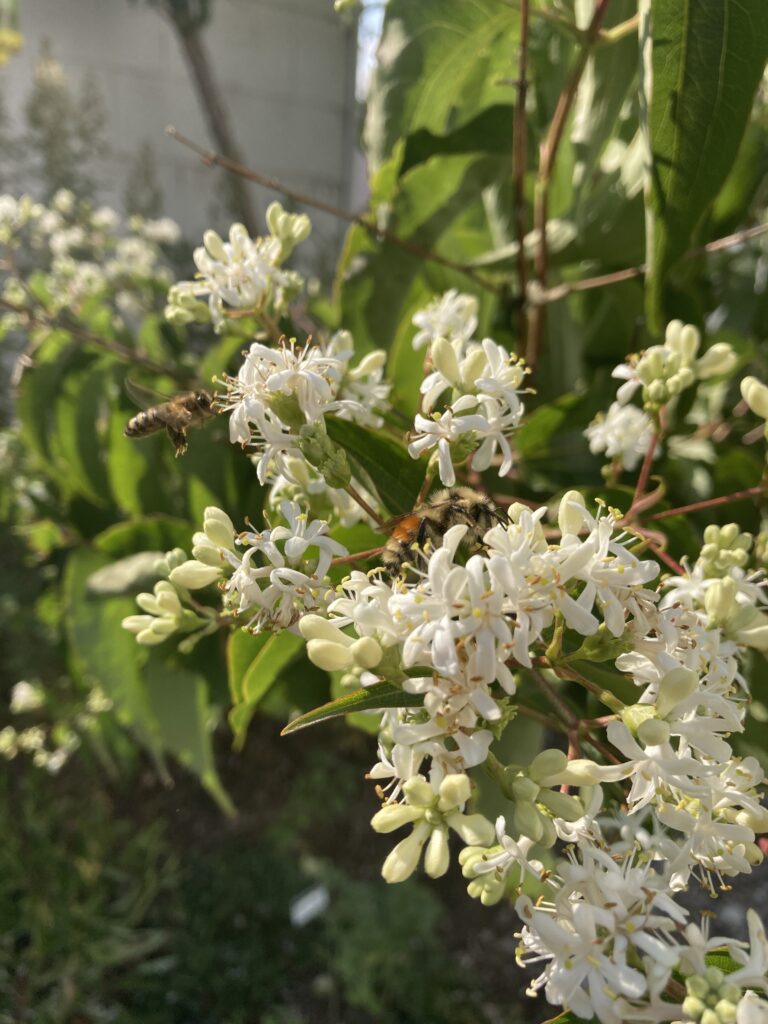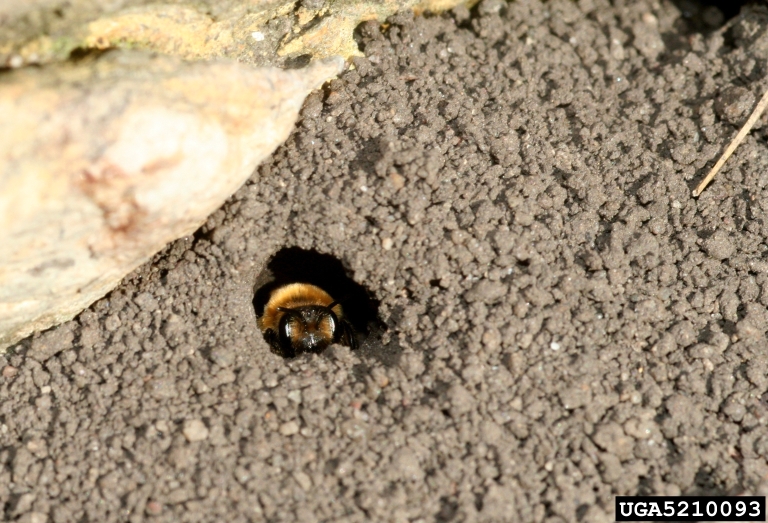From the Hort Desk
- 2023-05-04
- By mkirk
- Posted in Horticulture, The Garden Buzz
We are pleased to have guest author, Denyse Schrenker, Extension Specialist – Horticulture and Small Acreage Management at Eagle County Extension, contribute a timely article on mowing practices to help turf and pollinators. Thank you Denyse!

No Mow May? Let’s Help Pollinators All Year!
No Mow May keeps popping up on my news feeds so I decided to do a little digging. The idea is that pausing mowing for a month in the spring gives flowers in the lawn a chance to bloom. The goal behind the movement is to provide floral resources for pollinators at a time they are often limited. I don’t have to mow in May and it helps the bees! Sounds like a win-win to me.

Photo: Denyse Schrenker
I started looking into the research often cited as evidence for the benefits of not mowing in May. Although the concept largely gained popularity from a now retracted study, there is some research that shows decreased mowing is beneficial for bees and more broadly, arthropods. It is important to note that these studies did not specifically look at not mowing in May but at a reduced mowing frequency for the entire growing season. A study in Massachusetts found that lawns mowed every two weeks had the highest bee abundance compared to weekly mowing and mowing every three weeks, despite the lawns mowed every three weeks having the greatest abundance of flowers (Lerman et al. 2018). A meta-analysis looking at the effect of mowing frequency on arthropod abundance and diversity in urban settings found that decreased mowing frequency was strongly associated with increased arthropod diversity and moderately associated with increased abundance of arthropods (Proske et al. 2022). An unexpected but interesting finding from this study was a lower abundance of ‘pest species’ in lawns with reduced mowing schedules (Proske et al. 2022).

Bees on Seven Son Flower, Photo: Denyse Schrenker
Another consideration is the impact not mowing for a month will have on the health of the lawn (and your lawnmower!). Mowing more than ⅓ of the height of the lawn stresses the grass. While grass may not have grown tall enough in some areas of Colorado for this to be a major concern, in the lower elevations grass will be tall enough that waiting until June to mow could harm the health of the lawn. The flowers often found in lawns, such as dandelions, clovers and black medic, are adapted to mowing and flower under most mowing heights.
While No Mow May might not be the solution to saving the bees I had hoped for, there are many things we can do to benefit pollinators and the environment.
Raise your mowing height.
- Try raising your mower height to 3.5 inches, or if your mower allows, 4 inches and mow only as often as needed to remove no more than ⅓ of the grass height at a time. For example, when mowing at 3.5 inches, you should cut the lawn when it gets to around 5.25 inches tall. This management strategy could have the added benefit of reducing mowing frequency throughout the entire season which would reduce your carbon emissions.
When possible, do not bag the grass clippings.
- The grass clippings will break down and provide organic matter and nutrients to the soil, reducing the need for fertilizer and increasing the water holding capacity of the soil. This is another possible side effect of No Mow May, the grass clippings will likely be too great at the first mowing to leave in the lawn, and if composting is not an option for you, those clippings are off to the landfill where they contribute to methane emissions.

Ground nesting bee, Photo: Dr. Whitney Cranshaw, Colorado State University, bugwood.org
Create habitat for native bees.
- A vast majority of our native bees make their nests in the soil. Ground nesting bees prefer sunny, open areas with little vegetation cover so a dense and healthy lawn is not an ideal nest location.
- Scout your yard in April for ground nests and flag their location so you remember to leave that area undisturbed until early summer when the bees have moved out.
- Leave a sunny area of the yard bare and make sure that area is not under sprinkler irrigation. You can even provide mounds of different types of soil for them to choose their preferred nest building material.
- Remove weed barrier and landscaping fabric from the garden as it inhibits ground nesting bees.
- Rock walls, a shallow layer of river rock mulch, old stumps and logs, and the stems of native perennial plants are other habitats utilized by some native bees we can incorporate into our yards.
- Don’t forget about water! Add a bird bath or other shallow water source to your yard. Keep it filled with clean water and add a few rocks for bees and butterflies to stand on while they drink.
Use pollinator friendly pest management strategies.
- Reduce pesticide and fertilizer inputs as much as possible.
- Never spray a plant that is in bloom or about to bloom.
- Always read and follow the label instructions on pesticides, organic or not (it is the law!)
- Leave clovers and black medic in the lawn, they fix nitrogen and can help lower fertilizer needs.
Replace part of your lawn with a well-designed pollinator garden or a no-mow zone filled with native flowering plants. Lawns generally are not abundant or diverse resources for pollinators and dandelion pollen is a poor nutrient source for bees. Creating dedicated pollinator habitat will provide a rich source of floral resources all season long! Below are a few helpful resources for creating pollinator habitat:
- Creating Pollinator Habitat
- Attracting Native Bees to Your Landscape
- 10 Steps to a Pollinator Garden
- Low Water Native Plants for Pollinators
Check out these past CO-Horts blogs to learn more about all the amazing things pollinators do for us and how we can best help them: CO-Horts Pollinator Blogs. You can learn more about our native bees at NativeBeeWatch.org. Pollinators need our help, luckily there are many steps we can take that have a proven positive impact.
References:
Lerman, Susannah B., Alexandra R. Contosta, Joan Milam, and Christofer Bang. 2018. To mow or to mow less: Lawn mowing frequency affects bee abundance and diversity in suburban yards. Biological Conservation, Volume 221, Pages 160-174, ISSN 0006-3207, https://doi.org/10.1016/j.biocon.2018.01.025.
Proske, Anja, Sophie Lokatis, and Jens Rolff. 2022. Impact of mowing frequency on arthropod abundance and diversity in urban habitats: A meta-analysis. Urban Forestry & Urban Greening, Volume 76, 127714, ISSN 1618-8667, https://doi.org/10.1016/j.ufug.2022.127714.
Horticulture Resources
- Garden Buzz Archives
- CSU Extension Resources
- Colorado Master Gardener Program
- Foothills to Plains Native Plant Master Program
- Native Bee Watch Community Science Program
- The Co-Hort Blog
- PlantTalk Colorado
- Soil Testing
- Plant Select
- Emerald Ash Borer
- Japanese Beetle
- Colorado State Forest Service
- Ask an Expert


